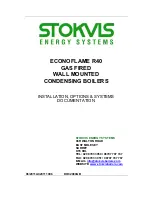
Flue gas system
Requirements and regulations
Materials
Flue gas data
12
Boiler
type
Nominal heat
output
Nominal heat
input
Flue gas
connection
CO
2
level
Flue gas
temperature
Flue gas
quantity
Max. permissible flue
resistance
kW
kW
mm
%
ºC
kg/s
Pa
max
min
max
min
max min max min
max
min
max
min
R40/65
60.8
10.1
62.4
10.4
100
8.5
8.5
76
33
0.033
0.005
150
15
R40/85
81.1
13.4
83.3
13.8
100
0.044
0.007
150
15
R40/100 92.9
15.6
95.2
16.0
100
8.7
8.5
76
33
0.049
0.008
150
15
R40/120 111.6 18.7 114.3 19.2
100
0.059
0.010
200
15
R40/150 132.2 23.3 135.5 23.9
130
0.070
0.012
200
15
Requirements and regulations
Regulations for the construction of flue
gas systems are very different for each
country. It should be ensured that all
national regulations with regard to flue
gas systems are respected. The most
important national norms can be found
in the chapter
"
Norms
"
.
Pay attention to the following
recom
mendations when dimensioning
a flue
gas system:
Only approved flue gas material may
be used.
The flue gas system must be properly
calculated to ensure a safe functioning
of the system.
Flue gas system components should be
removable for maintenance purposes.
Horizontal flue gas ways must be
mounted under an angle of 3º
mini
mum.
A separate condensate drain for the
chimney is not necessary, as the
con
densate can enter the drain via
the
syphon connection of the boiler.
The R40 is certified for the flue gas
systems B23 (and B23P for France)
and C13, C33, C43, C53, C63 and
C83.
Materials
Exclusively materials, which are heat
resistant and resistant to flue gases
and aggressive condensate, may be
used. Recommended materials are
plastic (PPS, category T120) or stain-
less steel. Aluminium (only thick wall!)
can also be used (in Germany only
after consulting the chimney sweeper).
The R40 has an integrated high limit
thermostat function for the flue gases.
When the fluegas temperature exceeds
90ºC, the burner is switched off. With
this function, an additional (external)
safety device is not necessary.
Flue gas data













































